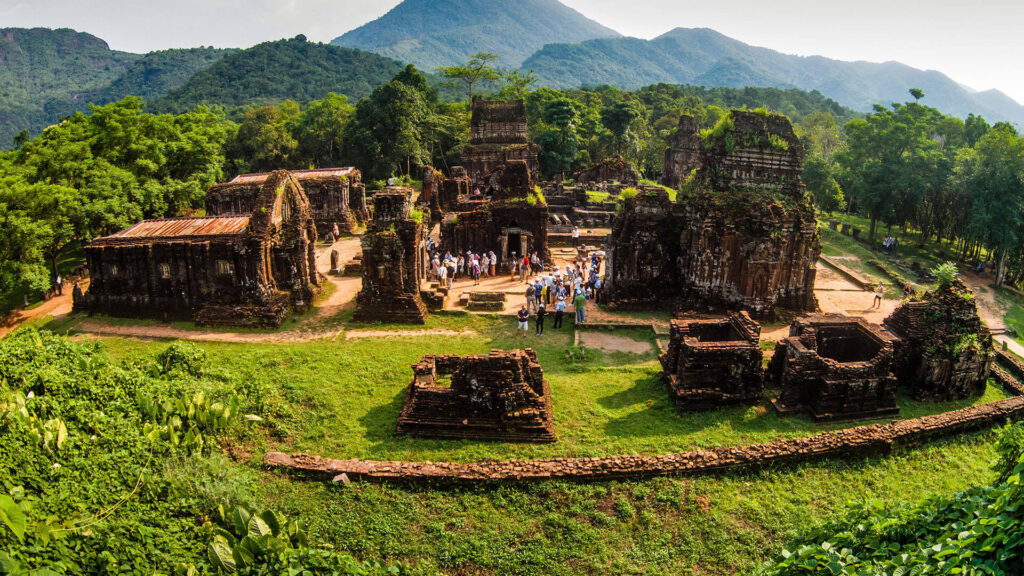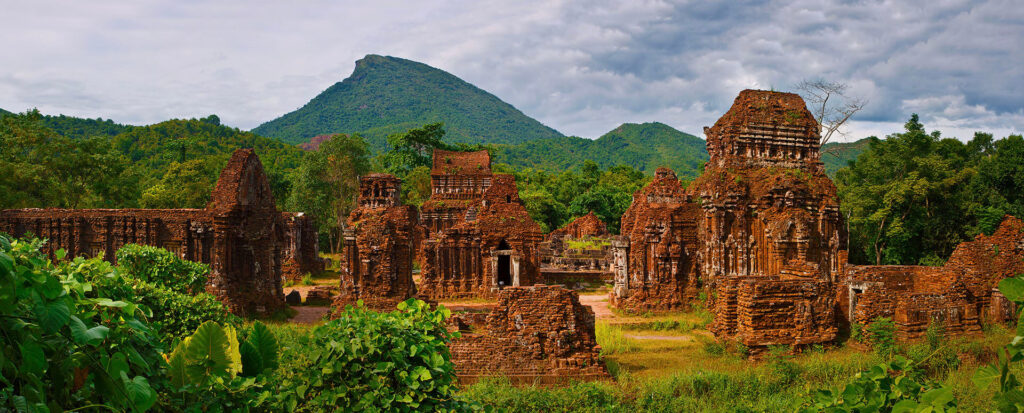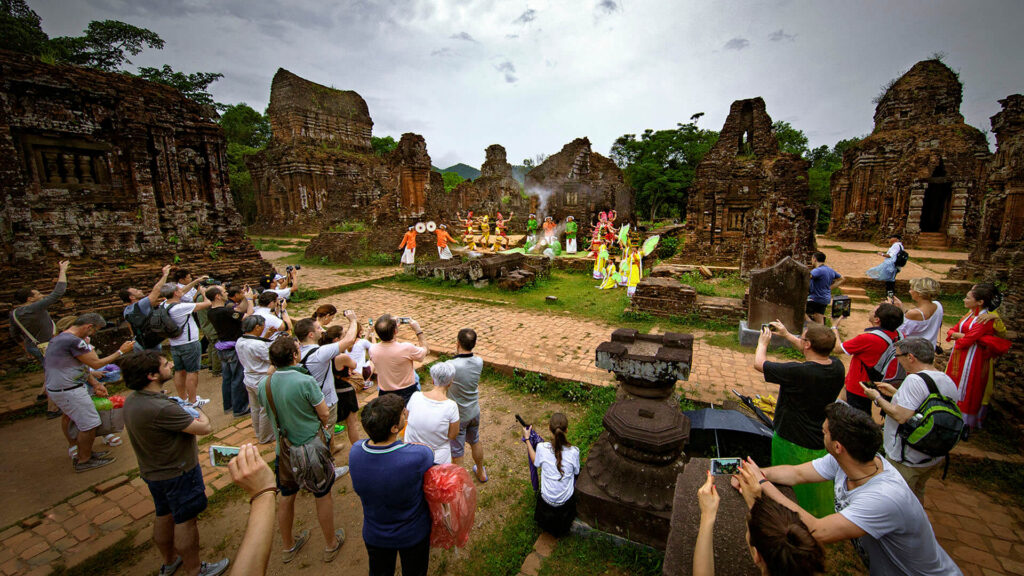My Son Sanctuary (also known as My Son Holy Land) is a complex of ancient Cham temples located in a secluded valley in My Son Village, Thu Bon Commune, Da Nang City.

This site preserves more than 70 temple structures built over many centuries (from the 4th to the 13th century), showcasing outstanding historical, cultural, architectural, and artistic values. My Son Sanctuary is regarded as a priceless museum of Cham architecture and sculpture, vividly reflecting the splendor of the ancient Champa civilization that still remains today.
CULTURAL HISTORY
My Son was established in the 4th century during the reign of King Bhadravarman, when the My Son valley was chosen as the holy capital—a major religious and spiritual center of the ancient Champa Kingdom. Located to the west of the capital Simhapura (Tra Kieu) and near the old trading port of Hoi An, the sanctuary lies amidst majestic mountains and is connected to a sacred stream flowing into the Thu Bon River.
From its earliest days, My Son became the site where Cham kings built temples to perform rituals, offer worship to the deities, affirm the legitimacy of their rule, and commemorate their victories. The temples here were primarily dedicated to the god Shiva, represented in the form of the linga—the supreme protector deity of the Champa Kingdom.
For nearly ten centuries, My Son was continuously restored and expanded by successive Champa dynasties. The first wooden temple was destroyed by fire in the 6th century but was rebuilt in the 7th century by King Sambhuvarman. From then on, each Cham king, upon ascending the throne, added new temples or restored damaged ones. As a result, My Son flourished, becoming the most important religious center of the entire kingdom.
There was a period of decline in the 8th–9th centuries when the capital was relocated and a new sanctuary was established in Nha Trang (Po Nagar). However, by the early 10th century, Shaivism was revived, and My Son was once again restored and expanded with the construction of numerous new temples.
In the 11th century, wars with neighboring states caused significant damage to the temples of My Son, but Cham kings later repaired and restored many of the structures. Construction and restoration efforts continued into the 13th century, with King Jaya Paramesvaravarman II (1234) regarded as the last monarch to have contributed to the sanctuary’s upkeep. After the 13th century, historical records no longer mention temple building at My Son, marking the end of nearly a millennium of continuous development.
Throughout this long journey, My Son bore witness to the flourishing of Cham culture and art, preserving within it a wealth of distinctive architectural styles across different historical periods.
ARCHITECTURE AND ART
In terms of layout, My Son’s architecture is distinctive and rare, designed as a sanctuary complex consisting of multiple temple clusters. The temples are arranged in groups, with each typically featuring a main temple (Kalan) at the center surrounded by smaller auxiliary towers, all enclosed by thick brick walls.
The main entrance of most central temples faces east—toward the sun god—while some of the larger temples also include a secondary entrance facing west. In front of the main sanctuary, there is usually a smaller gateway tower (Gopura) with two passages (one facing east, the other leading directly into the main temple). Following this is a long hall (Mandapa) with a tiled roof and spacious interior, serving as a place to welcome pilgrims, present offerings, and perform ritual dances in honor of the deities.
Around the central sanctuary, additional auxiliary towers and smaller architectural structures are arranged, creating a harmonious overall composition for Cham religious ceremonies and worship spaces.
All My Son temples are official religious structures, continuously built by Cham kings from the 4th to the 13th centuries. As such, each temple represents the finest essence of Cham architecture and artistry of its time. Nearly all recognized Cham architectural styles are present at My Son, and the temples here themselves have provided the foundational criteria for classifying Cham artistic styles.
In other words, My Son is a living museum of Cham architecture, preserving unique sculptures and decorative motifs that reflect the peak of intellect and craftsmanship of the ancient Cham people.
LANDSCAPE AND SETTING
My Son Sanctuary is set amidst a pristine and majestic natural landscape, surrounded by overlapping mountain ranges that create a solemn, deeply spiritual atmosphere. Standing out to the south of the valley is the sacred Mahaparvata Mountain (approximately 730 meters high), mentioned in inscriptions dating back to the 4th century.
In Cham symbolic belief, this mountain is likened to the giant linga of the god Shiva, while the My Son valley represents the yoni—together forming the cosmic union of fertility symbols embedded within the heritage site itself.

A sacred stream flows through the valley and connects to the Thu Bon River (Sanskrit: Mahadani – the embodiment of the goddess Ganga, wife of Shiva). This stream provides pure, perennial water used for purification rituals in Hindu ceremonies and festivals.
The forest ecosystem at My Son Sanctuary is also highly diverse, preserving many valuable plant species such as ironwood (Hopea odorata), rosewood (Dalbergia), Erythrophleum fordii, red chestnut, and melaleuca. It is also home to various wildlife species, including partridges, flying geckos, wild boars, and large muntjacs. The harmony between natural landscapes and the spiritual cultural space enhances the sacred, mystical aura of My Son, highlighting the significance of this heritage site amid the mountains and forests of Central Vietnam.
The harmony of natural landscapes with the spiritual and cultural space has added to the mysterious and sacred atmosphere of My Son, emphasizing the outstanding value of this heritage site amidst the mountains and forests of Central Vietnam.
OUTSTANDING VALUES
With its long history and unique artistry, My Son stands as a quintessential testament to the ancient Champa civilization. The temples here vividly reflect profound cultural exchanges: initially shaped by pure Hindu influence, later blended with indigenous beliefs, and ultimately evolving into a distinctly Cham identity.
In terms of architecture and sculpture, My Son encapsulates the finest essence of Cham art over nearly ten centuries, forming an invaluable heritage complex of global significance.
Many scholars consider My Son to be on par with other renowned temple complexes in the region such as Angkor Wat (Cambodia), Bagan (Myanmar), and Borobudur (Indonesia), both in scale and cultural–artistic value. Thanks to these outstanding universal values, My Son has gained global recognition, becoming a proud symbol of Vietnam’s heritage on the world cultural map.
TICKET PRICES
According to the My Son Sanctuary Management Board, the entrance ticket prices (including sightseeing and service fees) are currently applied as follows:
- International visitors: 150,000 VND per person per entry (including sightseeing and service fees).
- Vietnamese visitors: 100,000 VND per person per entry (including sightseeing and service fees).
BEST TIME TO VISIT & USEFUL TIPS
My Son lies within a tropical monsoon climate with two distinct seasons. The rainy season (around September to January of the following year) often brings heavy rainfall, slippery paths, and occasional flooding in the valley, making visits more challenging. In contrast, the dry season (from February to August) offers less rain and drier conditions, making it more convenient for travelers. Among these, February to April is considered the best time to visit, when the weather is cool and pleasant, and the forested landscape is lush with spring greenery, offering visitors a complete and enjoyable experience. Additionally, it is recommended to visit early in the morning to avoid the midday summer heat, enjoy the fresh atmosphere, and admire My Son’s mystical beauty in the sunrise glow.

NOTES FOR VISITORS
When visiting the My Son Sanctuary, visitors are kindly requested to observe the following rules and etiquette in order to protect the heritage and preserve its sacred cultural atmosphere:
- Follow the regulations of the Management Board; pay attention to instruction signs and comply with the rules at the site.
- Behave with civility and respect: maintain public order, speak politely and kindly to others, and show reverence toward the monuments.
- Dress appropriately: wear neat, modest, and respectful clothing when entering the temple towers (avoid revealing or inappropriate attire in this spiritual setting).
- Do not damage the heritage: strictly refrain from touching, climbing, or carving on brick walls, stone steles, trees, or any architectural structures within the sanctuary.
- Preserve cleanliness and landscape: be mindful of the environment, do not litter; help protect cultural works, architectural structures, and the natural surroundings of the heritage.
- Avoid superstitious practices: do not perform unauthorized rituals, offerings, or religious activities that conflict with local customs and cultural values within the site.
By following the above guidelines, visitors will enjoy a meaningful and safe trip while also contributing to the preservation of this invaluable cultural heritage of humanity – Mỹ Sơn Sanctuary – ensuring its values are passed down to future generations.
In recognition of these outstanding values, on December 4, 1999, Mỹ Sơn was inscribed on the UNESCO World Cultural Heritage List.
DANANG TOURISM PROMOTION CENTER